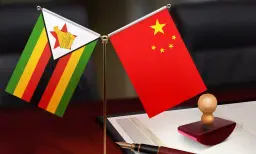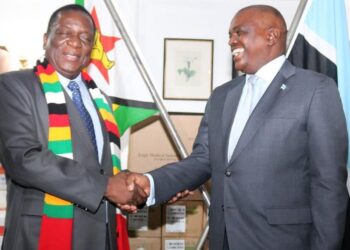Transport and Infrastructural Development Minister Felix Mhona addresses journalists on the sidelines of the World Economic Forum in China last week.
Freeman Razemba-Senior Reporter
Foreign investors should take advantage of the conducive investment climate created by the Second Republic to take up opportunities in all sectors of the economy, including transport, mining and manufacturing, Transport and Infrastructural Development Minister Felix Mhona said in China this week.
In the transport sector, investors can invest in road construction, climate-proofed and clean energy mobility, airports rehabilitation and expansion, mass urban transport systems, and rail refurbishment and rolling stock retooling.
Minister Mhona was speaking in China during the World Economic Forum where he led the Zimbabwean delegation. The WEF ran from June 27 to 29 under the theme: “China and Africa: Mutually Transformative”. Minister Mhona said in Zimbabwe, President Mnangagwa declared on several platforms that the country is open for business.
“Since 2017, Zimbabwe launched Vision 2030 to chart its new development trajectory. The vision reflects the collective aspirations and determination of the people of Zimbabwe to achieve a prosperous and empowered upper middle-income society by 2030,” said Minister Mhona.
“The vision is leveraged by the following priorities, among others: image building and international engagement and re-engagement, digital economy, and infrastructure and utilities.
“I find these priorities resonating well with the Tianjin Summer Davos of ‘Entrepreneurship, the driving force of the global economy’, which dovetails with our quest and aspiration to learn, cooperate and adopt standards on innovation, autonomy, connectivity, sustainable, climate proofed and safer infrastructure, shared and safer electric mobility.”
Minister Mhona said in Zimbabwe, new frontiers of transformative public transport developments and investments had arisen in areas such as road transport infrastructural development, climate-proofed and clean energy mobility, airports construction, rehabilitation and expansion, mass urban transport systems, and rail refurbishment and rolling stock retooling, for bulk freight and passenger railway transport solutions, including distributive centres within the framework of inland terminals to integrate the marine systems in neighbouring coastal nations and dry inland continental networks.
Other frontiers are transport network inter-modalities to integrate road, railway and aviation transport systems; e-tolling and traffic management systems within the framework of digitalisation; innovative and sustainable solutions towards enhanced mobility and mitigation of passage challenges; and smart ticketing, dynamic on-demand services such as smart public transport apps for enhanced safety, effective use and reduced public transport pollution.
Minister Mhona said the African Continental Free Trade Area (AfCFTA) was the largest free trade area in the world by the number of signatory countries and that it created a single market of 1,3 billion people with a combined GDP of US$3,4 trillion.
He said agriculture, agri-processing, automobile, pharmaceuticals, and transport and logistics, were some of the fastest growing China-African trade areas.
Annual flows of foreign-direct investment from China rose from US$75 million in 2003 to US$4,2 billion in 2020, with China now standing as Africa’s biggest trading partner, where the value of trade between China and Africa rose from US$10 billion in 2000 to $254 billion in 2021.
China is the main source of imports for most African countries.
Minister Mhona said Africa’s population was growing faster than that of any other continent.
“These trends will drive demand and create opportunities for trade between Africa and China,” he said. “In return, it is also factual that the cooperation has been transformative for China’s industrial manufacturing on a win-win basis.”
Investments in infrastructure such as roads and railways were crucial to the AfCFTA.
According to the African Development Bank, about US$130 billion to US$170 billion a year is needed in hard infrastructure, with a financing gap of US$68 billion to US$108 billion per year.
“Surely, the potential for increased collaboration between China and Africa is at its maximum more than ever before,” Minister Mhona said.
The Forum for China Africa Cooperation (Focac), which was established in 2000 as a platform for collective consultation and dialogue, has become an effective cooperation mechanism to promote development. Focac is expected to strengthen consultation and expand cooperation within a pragmatic framework, to promote political dialogue and economic cooperation with a view to seeking mutual reinforcement and cooperation.
“This is achieved through strategies and initiatives such as the Belt and Road Initiative, a global infrastructure development strategy adopted by the Chinese government in 2013, to invest in more than 150 countries and international organisations,” said Minister Mhona.
“The brainchild of Chinese President Xi Jinping is an ambitious economic development and commercial project that focuses on improving connectivity and cooperation among multiple countries, especially those spread across the continents of Asia, Africa and Europe.”
The BRI objective promotes economic prosperity of the countries along the belt and road, and regional economic cooperation to strengthen exchange, and mutual learning amongst different civilisations and to promote world peace and development.
Source ZimSituation








